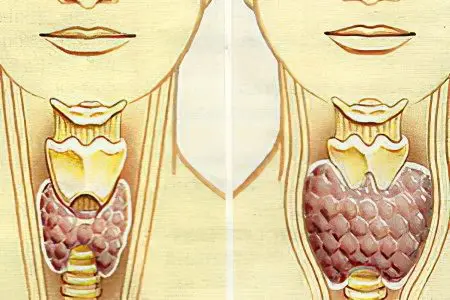Contents
- What is thyroid enlargement
- Causes of an enlarged thyroid gland
- Symptoms of an enlarged thyroid gland
- Test to determine the level of iodine in the body
- The degree of enlargement of the thyroid gland
- What threatens an enlarged thyroid gland?
- Diagnosis of an enlarged thyroid gland
- Treatment for enlarged thyroid
- Prevention of thyroid enlargement
Thyroid gland is an organ related to the endocrine glands. It is located on the front of the neck and consists of two lobes located on the sides of the trachea and connected by an isthmus. The size of each lobe is approximately 3 × 2 × 1,5 cm. The thyroid gland of a newborn child weighs 2-3 g, an adult – 12-25 g. The normal volume of the thyroid gland is within 25 ml in men and 18 ml in women.
The connective tissue of the thyroid gland contains follicles whose cells (thyrocytes) produce thyroid iodine containing hormones: triiodothyronine (T3) and thyroxine (T4). These hormones are involved in the regulation of fat, protein and carbohydrate metabolism, the functioning of the gastrointestinal tract, cardiovascular, nervous and reproductive systems. Normally, the thyroid gland is practically not palpable.
What is thyroid enlargement

An enlarged thyroid gland is a clinical symptom of a number of diseases of this organ with different etiologies. In the people, an increase in the thyroid gland is usually called a “goiter”, since in this case a noticeable convex formation appears on the neck, similar to a bird’s goiter.
The most common cause of goiter is a decrease in gland function due to a deficiency of iodine entering the body (hypothyroidism). Severe hypothyroidism is diagnosed in 2–5% of the Russian population, minor symptoms are observed in another 20–40%. In women, thyroid pathologies occur 5 times more often than in men, young people suffer from this less often than the elderly. Often, hypothyroidism remains undiagnosed, since such symptoms as a general decrease in vitality, lethargy, chilliness, brittleness and hair loss, etc. are not specific, but may be signs of many diseases.
Causes of an enlarged thyroid gland
Common causes of an enlarged thyroid gland include the following:
Deficiency in food and water of iodine and some other trace elements (fluorine, selenium);
Poor environmental conditions, when toxic substances from the environment enter the body, which affects the functioning of the thyroid gland;
The presence in the blood of inhibitors of the synthesis of thyroid hormones, which include sulfonamides, aminosalicylic acid, resorcinol. There is an opinion that substances that prevent the production of thyroid hormones are found in turnips and soy products;
Hypovitaminosis (vitamin D deficiency);
The presence in the body of some bacterial infections that suppress the activity of the thyroid gland;
chronic stress;
Lack of physical activity;
Congenital hereditary predisposition;
Pathologies of the pituitary and hypothalamus, the hormones of which regulate and control the function of the thyroid gland.
The above reasons can lead to the development of one of three syndromes characterized by an enlarged thyroid gland:
Gipotireoz. An insufficient amount of iodine in the diet leads to insufficient production of thyroid hormones, as a result of which the thyroid gland begins to work in an intensive mode and increase in size. Hypothyroidism can be primary or secondary. Primary, due to dysfunction of the thyroid gland itself, the secondary is associated with pathologies of the pituitary and hypothalamus, with a deficiency of thyroid-stimulating hormone produced by the pituitary gland.
Hyperthyroidism. In this case, an excessive amount of thyroid hormones is produced that exceeds the norm. The reason for this may be Graves’ disease (diffuse toxic goiter), thyroiditis (inflammation of the thyroid gland), various tumor neoplasms of the gland itself, the pituitary gland and the hypothalamus. With hyperthyroidism, metabolic processes in the body are accelerated.
Euthyroidism. With this pathology, the thyroid gland is enlarged, but the level of hormones in the blood, according to the results of the tests, is not changed. With the help of compensatory mechanisms, the body copes with iodine deficiency: thyroid-stimulating hormone is produced by the pituitary gland in an enhanced mode, thereby supporting the function of the thyroid gland. Euthyroid goiter often develops during puberty, pregnancy, or postmenopause.
Goiter can be diffuse, when the thyroid gland is evenly enlarged, and nodular, with local autonomous formations in the gland. In the latter case, against the background of iodine deficiency, some thyrocytes go beyond the regulatory influence of thyroid-stimulating hormone produced by the pituitary gland, which is accompanied by the formation of nodes in the gland tissue. Nodular goiter is more common in people over 50 years of age.
Also, depending on the causes of the enlargement of the thyroid gland, it is divided into endemic and sporadic goiter. The appearance of endemic goiter is due to a lack of iodine in the environment: in food, soil, etc. Sporadic goiter develops in people living in regions with enough iodine. Like endemic, it can be diffuse or nodular, as well as mixed. In this case, the provoking factors can be bad ecology, exposure to radiation, unfavorable heredity, taking certain medications.
Symptoms of an enlarged thyroid gland

Common symptoms of thyroid dysfunction are:
Change in weight in the direction of increase or decrease in the absence of changes in volume and diet;
Violation of the heart rhythm;
Progressive hair loss;
Violation of thermoregulation: chills or a feeling of heat;
Rapid fatigue, constant fatigue;
Increased irritability, sleep disorder;
Menstrual disorders in women and problems with potency in men;
vision problems;
Nausea, vomiting, gastrointestinal disorders (constipation, diarrhea).
As mentioned above, dysfunction of the thyroid gland can take two forms: its decrease (hypothyroidism), characterized by a reduced level of thyroid hormones, and excessive activity (hyperthyroidism or thyrotoxicosis), manifested in excessive production of hormones. Depending on this, the symptoms of an enlarged thyroid gland may vary.
Symptoms of hypothyroidism:
An increase in body weight due to a slowdown in metabolic processes in the body;
Dryness, brittleness and hair loss;
Tendency to chilliness, chills, poor cold tolerance;
Swelling of the face and eyelids, as well as limbs;
Decreased appetite;
dry mouth;
Slow heart rate: pulse below 60 beats per minute;
Decreased blood pressure;
Nausea, vomiting, constipation, flatulence;
Increased cholesterol in the blood;
General weakness, lethargy, drowsiness;
Difficulty breathing, hoarseness, hearing loss;
depression, depressed mood;
Headache;
Dryness, peeling, pallor or yellowness of the skin;
Tingling in the hands;
Violation of the menstrual cycle in women;
signs of anemia;
Memory impairment, decreased performance.
Symptoms of hyperthyroidism:
Weight loss with good nutrition and increased appetite;
Acceleration of the heart rate: pulse more than 90 beats per minute;
Increased blood pressure, shortness of breath;
Thinning hair and brittle nails, early gray hair;
Poor heat tolerance and increased sweating;
Humidity of the skin, in some cases – violations of its pigmentation;
Feeling thirsty, frequent urination;
Gastrointestinal disorders: vomiting, diarrhea, constipation;
Muscle weakness and fatigue;
Hand tremor;
Vision problems: photophobia, lacrimation, development of bulging eyes;
Disorder of sexual function;
Increased excitability, nervousness, irritability, anxiety, feeling of fear;
Sleep disorder.
Usually, only some of the listed symptoms are observed. In the elderly, severe symptoms may be absent altogether. Hearing impairment in hypothyroidism occurs due to swelling of the Eustachian tube. With euthyroid goiter (when the level of hormones in the blood is within the normal range), the leading complaint is a cosmetic defect, a feeling of discomfort and heaviness in the neck. A significant enlargement of the gland can put pressure on nearby blood vessels and organs. When squeezing the trachea, coughing, shortness of breath appear, when squeezing the esophagus – difficulties and pain when swallowing food, especially solid food. There is discomfort when wearing scarves and clothes with high collars.
With inflammation of the gland or hemorrhage in the nodular goiter, pains appear in the neck, the temperature rises, the goiter begins to rapidly increase in size.
Almost always there are symptoms related to the nervous system. The person becomes irritable, nervous, quick-tempered, prone to mood swings. In hyperthyroidism, this is accompanied by increased physical activity and aggression. A common symptom is a fine tremor of the fingers, which increases when the arms are stretched out. Children have tics – violent movements of the muscles of the face and limbs.
Another characteristic symptom is changes in the functioning of the cardiovascular system. An increase in thyroid function is accompanied by tachycardia, a decrease – by bradycardia. Often these signs precede visual enlargement of the gland. Shortness of breath with hyperthyroidism is usually associated not with cardiac activity, but with a constant feeling of heat. Typical is an increase in systolic (upper) pressure, while diastolic (lower) pressure may remain normal. With prolonged hyperthyroidism and untreated, there is a risk of developing osteoporosis.
Hyperfunction of the thyroid gland is always accompanied by heavy sweating of the whole body. The skin becomes thin, moist, prone to redness, itching is possible. Muscle weakness affects mainly the muscles of the arms and shoulder girdle.
A characteristic sign of diffuse goiter is endocrine ophthalmopathy, which is a consequence of an autoimmune lesion of the thyroid gland (Basedow’s disease). In the early stages of the process, dry eyes, photophobia, and swelling of the eyelids are noted. In the future, protrusion of the eyeballs and limitation of their mobility are observed, exophthalmos (incomplete closure of the upper and lower eyelids) may develop.
How to determine the enlargement of the thyroid gland?
The normal size of the thyroid gland is within 25 ml in men and 18 ml in women. With the development of diseases, the volume of the gland increases, as it begins to work in an enhanced mode, producing an excess amount of hormones or trying to maintain their production at the required level.
If you put your hand in front of the neck so that the thumb is on one side of the cartilage, and the other four on the other, then you can feel for a soft formation. This is the thyroid gland. Normally, its length is equal to the length of the extreme phalanx of the thumb (on which the nail is located). The gland should have a soft and elastic consistency and move with the cartilage during swallowing movements. If it seems that the size of the gland is larger, and its structure is too dense, or local nodular formations are found in it, then it is recommended to visit an endocrinologist for an examination.
Test to determine the level of iodine in the body
You need to take the usual 3-5% iodine and use a cotton swab to apply an iodine mesh overnight on any part of the body (with the exception of the thyroid gland). It can be the chest, lower abdomen or thigh. If by morning the grid disappears or becomes completely pale, this indicates an iodine deficiency. If during the day the color of the grid remains practically unchanged, this indicates an excess of iodine in the body.
You can make this test more accurate. Before going to bed, apply three lines on the forearm with an iodine solution: thin, slightly thicker and thick. If the first line disappears in the morning, then everything is fine with the iodine content in the body. If two thicker ones disappear, it is recommended to check the thyroid gland. If there are no traces left on the skin, there is a clear lack of iodine.
The degree of enlargement of the thyroid gland

Normally, the thyroid gland is not visually noticeable and is practically not palpable.
The simplest classification of goiter sizes is used by the World Health Organization (WHO) and includes three degrees of thyroid enlargement:
Zero Degree: the goiter is absent, the gland is palpable, the size of the lobes corresponds to the length of the nail phalanges of the thumbs;
First degree: an increase in the gland is palpable, but the goiter is not visually noticeable in the normal position of the head;
Second degree: the goiter is palpable and visible to the eye.
In Russia, the most common classification of Professor O.V. Nikolaev.
According to this classification system, five degrees of goiter development are distinguished, each of which has its own clinical signs:
First degree: The thyroid gland is not visually changed, the changes are not palpable, but at the time of swallowing, an isthmus is visible connecting the lobes of the gland.
Second degree: The lobes of the gland are well palpated and visible during swallowing. The outlines of the neck while still remain the same.
Third degree: The goiter and isthmus of the gland become clearly visible, the neck thickens, but this does not yet cause pronounced physical discomfort.
Fourth degree: The goiter continues to grow, the outlines of the neck change greatly, the contours of the lobes of the gland are drawn on it, visible even in a state of immobility and rest.
Fifth degree: The goiter becomes large and begins to compress nearby organs: the trachea, esophagus, blood arteries, vocal cords, which may be accompanied by shortness of breath, difficulty in chewing and swallowing, a feeling of heaviness in the chest, headaches, voice changes.
Ultrasound allows you to determine the size of the thyroid gland most accurately, since during visual examination errors are possible, which depend on the development of the cervical muscles, the thickness of the fat layer, and the location of the gland. Its value is calculated by the formula:
The volume of one lobe = (length) × (width) × (thickness) × 0,48.
Then the volume indicators of the two shares are summed up. The size of the isthmus does not have significant diagnostic value.
What threatens an enlarged thyroid gland?
Pathologies of the thyroid gland cause violations of all types of metabolism: protein, carbohydrate, fat; negatively affect the activity of the nervous and cardiovascular systems.
Left untreated, it can lead to serious and life-threatening consequences:
An enlarged thyroid gland puts pressure on nearby organs, which is accompanied by circulatory, respiratory and swallowing disorders;
From the side of the cardiovascular system, there are cardiac arrhythmias (tachycardia, bradycardia, arrhythmia), jumps in blood pressure;
On the part of the nervous system, imbalance appears, an inability to control one’s emotions, a tendency to depressive states;
By itself, a large goiter is a large cosmetic defect;
With hyperthyroidism (thyrotoxicosis), a complication such as a thyrotoxic crisis (a sharp release of a large amount of thyroid hormones into the blood) is possible. In this case, immediate hospitalization is required, as a severe crisis can be fatal.
Diagnosis of an enlarged thyroid gland

The main procedures necessary for making a diagnosis include:
Medical examination. The endicrinologist listens to complaints and palpates the organ. With superficial palpation, the general size of the gland and the nature of the increase (diffuse or nodular) are determined. With deep palpation, the consistency of the organ (soft or dense), soreness, pulsation (normally, soreness and pulsation are absent), mobility are analyzed. A healthy thyroid gland is soft, mobile, has a uniform consistency and a smooth surface, there is no cohesion with surrounding tissues.
Blood test for hormones. To diagnose thyroid pathologies, the level of thyroid-stimulating hormone (TSH), hormones T4 and T3 is detected. Thyroid-stimulating hormone is produced by the pituitary gland and regulates thyroid function. A high concentration of this hormone indicates its reduced function. The thyroid gland’s own hormones, thyroxine (T4) and triiodothyronine (T3), are mainly found in the blood in a bound state and depend on whey proteins. Hormonal activity of the thyroid gland is determined by the concentration of free T3 and T4. However, in general, an increased level of thyroxine and triiodothyronine is observed with hyperfunction of the gland (hyperthyroidism and thyroiditis), a lower level – with hypothyroidism.
Thyroid ultrasound. An ultrasound examination establishes the size of the gland, the degree of increase, the absence or presence of nodular formations.
If nodes larger than 1 cm in diameter are detected in the thyroid gland, additional studies may be prescribed:
Needle biopsy. Performed when a tumor is suspected. In this case, a cytological and histological analysis of tissue cells removed from the compaction in the gland is done.
Magnetic resonance and computed tomography. These methods are more informative than ultrasound. The location, size, contours, structure of the thyroid gland, the density of existing nodes are assessed.
Radioisotope research (scanning). With its help, the size and shape of the organ, the activity of nodular formations are determined. It is believed that the results of the application of this method can suggest the presence or absence of a malignant process in the gland.
Study of the absorption of radioactive iodine by the thyroid gland (used in rare cases).
General studies and analyzes are also assigned:
General blood analysis;
General urine analysis;
Biochemical blood test to determine the level of bilirubin, liver enzymes, urea, creatinine, serum proteins, etc.;
Determining the level of cholesterol: with hyperfunction of the gland, cholesterol is usually lowered, with hypofunction – increased. However, high cholesterol can also be caused by many other diseases (the most informative use of this indicator when making a diagnosis in children);
Chest X-ray. With a large goiter and its retrosternal location, an x-ray allows you to identify the degree of enlargement of the gland, assess the condition of the esophagus and trachea;
Electrocardiogram, etc.
In each case, diagnostic methods are selected individually, depending on the history and characteristics of the pathology.
Treatment for enlarged thyroid
With timely started and adequate treatment, it is possible to reduce the gland to its natural size and restore its normal function. The first priority is to normalize the level of thyroid hormones.
Treatment of hypothyroidism

Thyroid hormone preparations are taken as replacement therapy. These include Levothyroxine sodium, Euthyrox, Liothyronine, Triiodothyronine. The dosage is prescribed individually according to the results of the examination. Also, these drugs are used for neoplasms in the thyroid gland, as suppressors for diffuse non-toxic goiter, to prevent relapses after removal of part of the gland.
With primary hypofunction and endemic goiter, during treatment with hormones, it is necessary to monitor the level of thyroid-stimulating hormone; with secondary hypothyroidism – monitor the level of free T4.
With extreme caution, thyroid hormones should be used in patients with cardiovascular diseases (ischemia, angina pectoris, hypertension) and impaired liver and kidney function. During pregnancy, the need for hormones increases by 30-45%.
Treatment of hyperthyroidism
There are three main ways to treat hyperthyroidism: drug treatment, surgical removal of all or part of the gland, and radioactive iodine therapy, which destroys excess gland tissue and nodules.
Treatment with medicines consists in the use of thyreostatic drugs that suppress excessive thyroid activity. These include Propylthiouracil, Propicil, Mercazolil, Thiamazole, Tyrozol, lithium preparations. Iodine preparations prevent the release of T3 and T4 from the thyroid gland, inhibit their synthesis, the capture of iodine by the gland and the transition of thyroid hormones into the active form. Contraindications to their appointment are severe liver damage, leukopenia, lactation.
Treatment with radioactive iodine is indicated for patients over the age of 40 years. The complexity of this method lies in the fact that it is very difficult to choose the right dosage and predict the reaction of the thyroid gland. There are frequent cases when, after it was possible to normalize the function of the thyroid gland, hypothyroidism begins to develop in the future and maintenance therapy is required.
Surgery is performed in the following cases:
The presence of nodes in the thyroid gland, the size of which exceeds 2,5–3 cm;
The presence of cysts larger than 3 cm;
Thyroid adenoma;
Retrosternal location of nodular goiter;
Suspicion of a malignant tumor.
Prevention of thyroid enlargement

When living in iodine-deficient regions, it is recommended to take iodine preparations, eat foods high in iodine, replace ordinary table salt with iodized salt. Iodine preparations must be taken systematically, in courses, and it is better to do this under the supervision of a doctor, since an overdose of iodine is as dangerous as its deficiency. Elderly people with an enlarged thyroid gland and people with nodular goiter should be especially careful with these drugs.
Foods rich in iodine:
Seaweed (dried, frozen, canned);
A fish;
All seafood: shrimp, squid, mussels, shellfish;
Grain embryos; bread made from low-grade flour and bran.
To compensate for the lack of iodine, these products should be eaten regularly, and not occasionally. Prolonged cooking reduces the iodine content of the product.
Also, some vegetables and legumes contain substances that affect the absorption of iodine by the body: they prevent its entry into the thyroid gland or inhibit the activity of enzymes involved in the synthesis of thyroid hormones. These include turnips, rutabagas, radishes, dill, beans.
Nutrition for hypothyroidism
With hypothyroidism, it is recommended to reduce the calorie intake, especially carbohydrates and saturated fats with a high cholesterol content. The use of protein food should correspond to physiological norms. Proper organization of recreation is also necessary, a vacation by the sea is useful.
Nutrition for hyperthyroidism
With thyrotoxicosis, the basal metabolism is accelerated, which leads to increased energy consumption, therefore, in this case, a high-calorie diet is recommended, in which the content of proteins, carbohydrates and fats should be well balanced. Easily digestible proteins should be preferred, among which dairy products can be put in the first place. Also, dairy products are an excellent source of calcium, the need for which is increased in people with hyperthyroidism.
Of great importance in hyperfunction of the thyroid gland is the sufficient content of vitamins and trace elements in food. It is necessary to limit the use of foods and drinks that stimulate the cardiovascular system and the central nervous system: strong coffee and tea, chocolate, cocoa, spices, rich meat and fish broths. It is better to switch to fractional meals, 4-5 times a day, drink enough water. Of the drinks, decoctions of wild rose and wheat bran, diluted fruit juices (with the exception of plum, apricot, grape) are useful.









